Classroom Management: Theoretical Schools and Start of Year Plan
VerifiedAdded on 2022/08/10
|10
|2010
|57
Report
AI Summary
This report presents a comprehensive classroom management plan, fulfilling the requirements of an academic assignment. The first part of the report compares the cognitive and humanistic schools of thought, exploring their key characteristics, similarities, and differences. The cognitive school emphasizes how individuals process, acquire, and store information, focusing on the organization and structure of learning, while the humanistic school prioritizes student interests, needs, and personal growth within a supportive environment. The second part of the report develops a "start of year" plan, which includes three key strategies: a proper seating plan to facilitate interaction and behavior, non-verbal cues to establish rapport and manage the classroom, and the provision of visual supports to enhance learning. The report draws on relevant literature to support its arguments and provide practical recommendations for educators. This assignment demonstrates an understanding of classroom management theories and the ability to translate theory into practice.
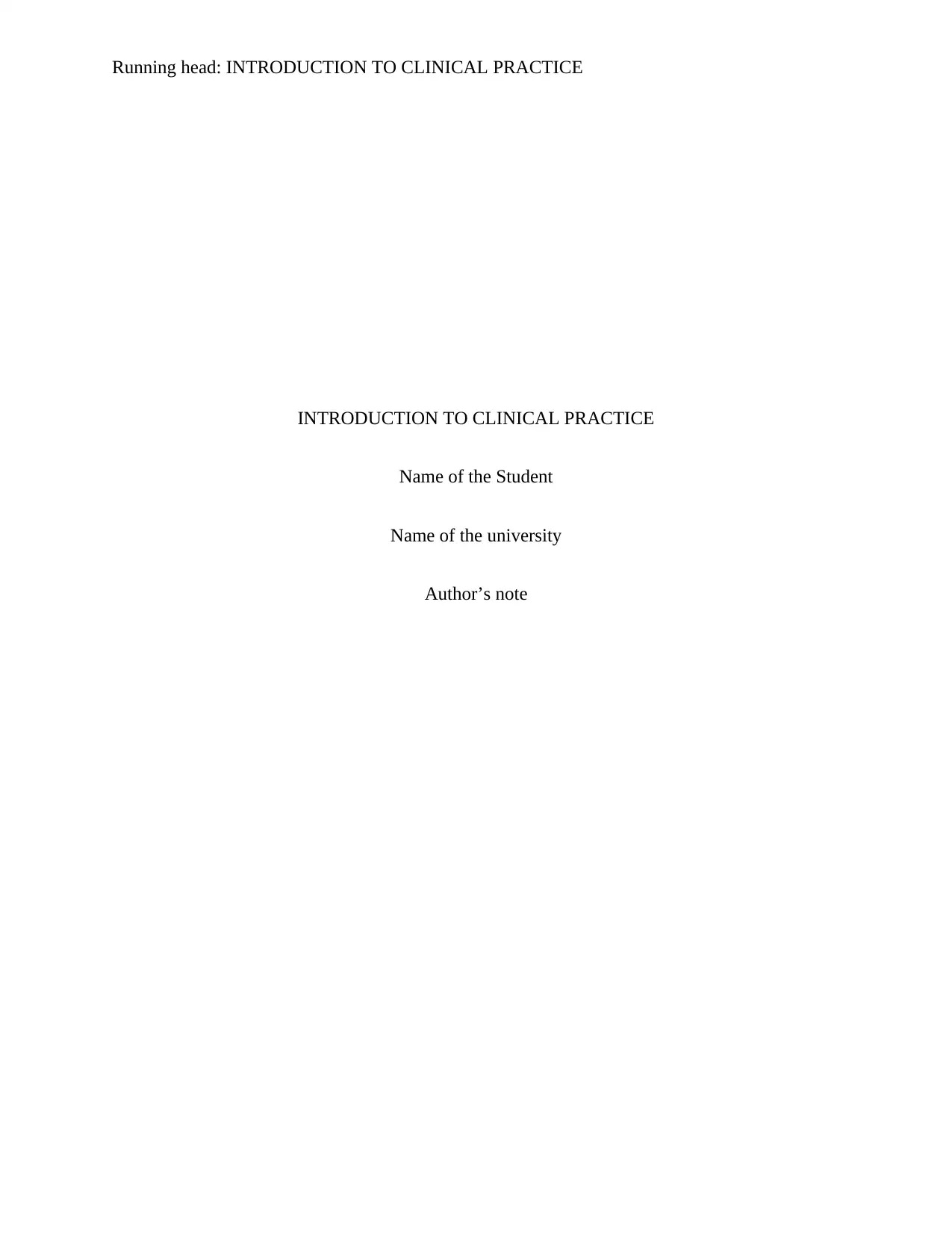
Running head: INTRODUCTION TO CLINICAL PRACTICE
INTRODUCTION TO CLINICAL PRACTICE
Name of the Student
Name of the university
Author’s note
INTRODUCTION TO CLINICAL PRACTICE
Name of the Student
Name of the university
Author’s note
Paraphrase This Document
Need a fresh take? Get an instant paraphrase of this document with our AI Paraphraser
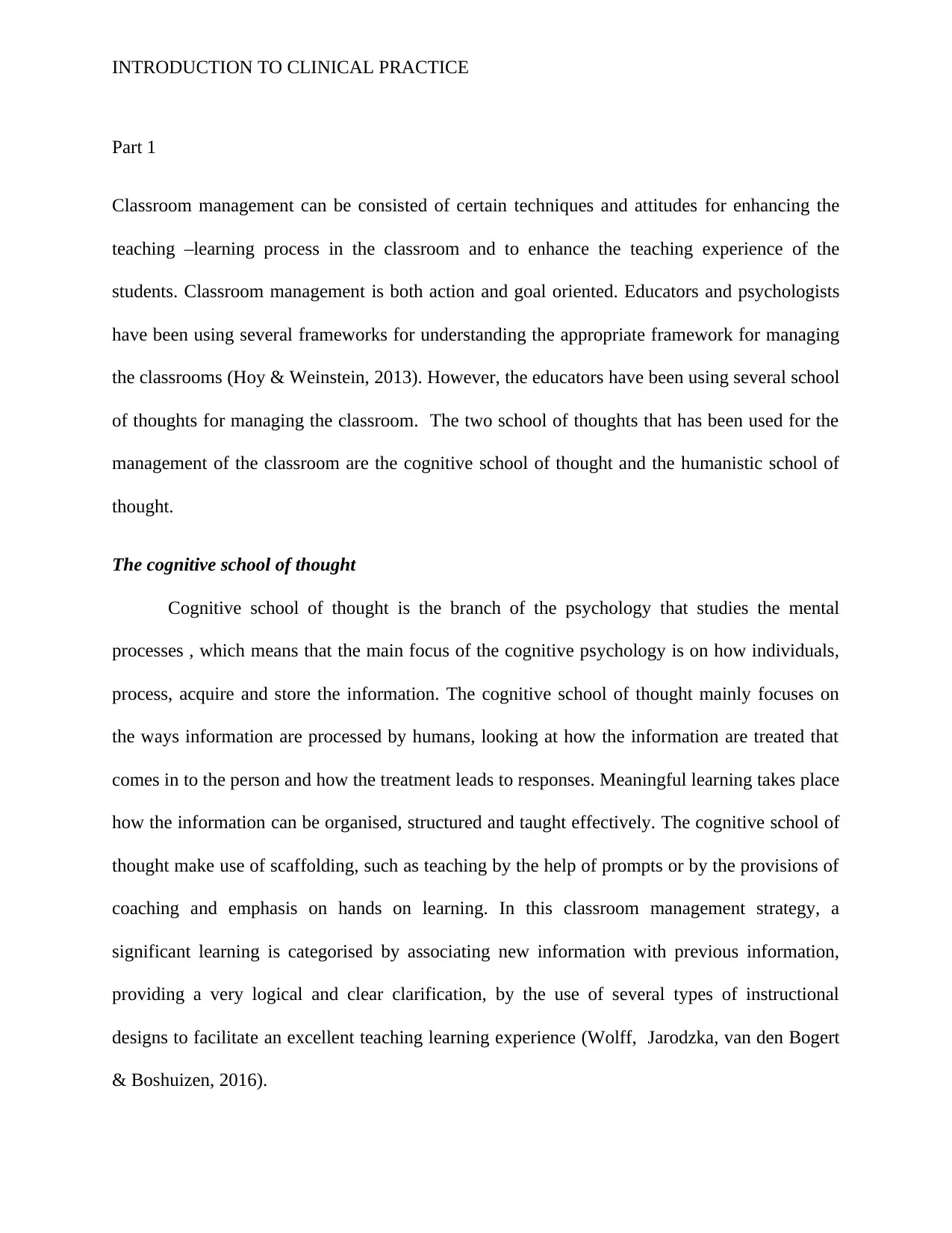
INTRODUCTION TO CLINICAL PRACTICE
Part 1
Classroom management can be consisted of certain techniques and attitudes for enhancing the
teaching –learning process in the classroom and to enhance the teaching experience of the
students. Classroom management is both action and goal oriented. Educators and psychologists
have been using several frameworks for understanding the appropriate framework for managing
the classrooms (Hoy & Weinstein, 2013). However, the educators have been using several school
of thoughts for managing the classroom. The two school of thoughts that has been used for the
management of the classroom are the cognitive school of thought and the humanistic school of
thought.
The cognitive school of thought
Cognitive school of thought is the branch of the psychology that studies the mental
processes , which means that the main focus of the cognitive psychology is on how individuals,
process, acquire and store the information. The cognitive school of thought mainly focuses on
the ways information are processed by humans, looking at how the information are treated that
comes in to the person and how the treatment leads to responses. Meaningful learning takes place
how the information can be organised, structured and taught effectively. The cognitive school of
thought make use of scaffolding, such as teaching by the help of prompts or by the provisions of
coaching and emphasis on hands on learning. In this classroom management strategy, a
significant learning is categorised by associating new information with previous information,
providing a very logical and clear clarification, by the use of several types of instructional
designs to facilitate an excellent teaching learning experience (Wolff, Jarodzka, van den Bogert
& Boshuizen, 2016).
Part 1
Classroom management can be consisted of certain techniques and attitudes for enhancing the
teaching –learning process in the classroom and to enhance the teaching experience of the
students. Classroom management is both action and goal oriented. Educators and psychologists
have been using several frameworks for understanding the appropriate framework for managing
the classrooms (Hoy & Weinstein, 2013). However, the educators have been using several school
of thoughts for managing the classroom. The two school of thoughts that has been used for the
management of the classroom are the cognitive school of thought and the humanistic school of
thought.
The cognitive school of thought
Cognitive school of thought is the branch of the psychology that studies the mental
processes , which means that the main focus of the cognitive psychology is on how individuals,
process, acquire and store the information. The cognitive school of thought mainly focuses on
the ways information are processed by humans, looking at how the information are treated that
comes in to the person and how the treatment leads to responses. Meaningful learning takes place
how the information can be organised, structured and taught effectively. The cognitive school of
thought make use of scaffolding, such as teaching by the help of prompts or by the provisions of
coaching and emphasis on hands on learning. In this classroom management strategy, a
significant learning is categorised by associating new information with previous information,
providing a very logical and clear clarification, by the use of several types of instructional
designs to facilitate an excellent teaching learning experience (Wolff, Jarodzka, van den Bogert
& Boshuizen, 2016).
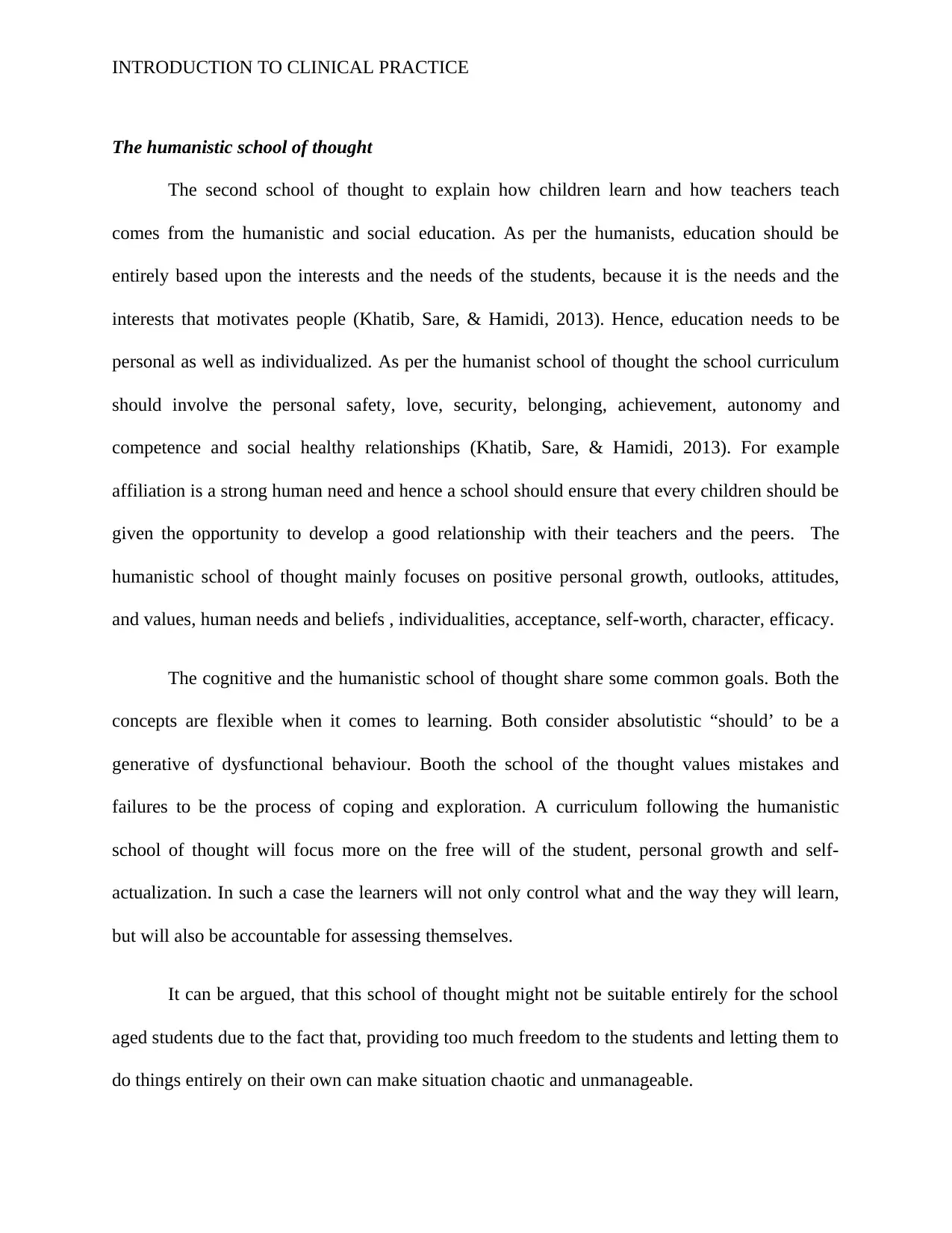
INTRODUCTION TO CLINICAL PRACTICE
The humanistic school of thought
The second school of thought to explain how children learn and how teachers teach
comes from the humanistic and social education. As per the humanists, education should be
entirely based upon the interests and the needs of the students, because it is the needs and the
interests that motivates people (Khatib, Sare, & Hamidi, 2013). Hence, education needs to be
personal as well as individualized. As per the humanist school of thought the school curriculum
should involve the personal safety, love, security, belonging, achievement, autonomy and
competence and social healthy relationships (Khatib, Sare, & Hamidi, 2013). For example
affiliation is a strong human need and hence a school should ensure that every children should be
given the opportunity to develop a good relationship with their teachers and the peers. The
humanistic school of thought mainly focuses on positive personal growth, outlooks, attitudes,
and values, human needs and beliefs , individualities, acceptance, self-worth, character, efficacy.
The cognitive and the humanistic school of thought share some common goals. Both the
concepts are flexible when it comes to learning. Both consider absolutistic “should’ to be a
generative of dysfunctional behaviour. Booth the school of the thought values mistakes and
failures to be the process of coping and exploration. A curriculum following the humanistic
school of thought will focus more on the free will of the student, personal growth and self-
actualization. In such a case the learners will not only control what and the way they will learn,
but will also be accountable for assessing themselves.
It can be argued, that this school of thought might not be suitable entirely for the school
aged students due to the fact that, providing too much freedom to the students and letting them to
do things entirely on their own can make situation chaotic and unmanageable.
The humanistic school of thought
The second school of thought to explain how children learn and how teachers teach
comes from the humanistic and social education. As per the humanists, education should be
entirely based upon the interests and the needs of the students, because it is the needs and the
interests that motivates people (Khatib, Sare, & Hamidi, 2013). Hence, education needs to be
personal as well as individualized. As per the humanist school of thought the school curriculum
should involve the personal safety, love, security, belonging, achievement, autonomy and
competence and social healthy relationships (Khatib, Sare, & Hamidi, 2013). For example
affiliation is a strong human need and hence a school should ensure that every children should be
given the opportunity to develop a good relationship with their teachers and the peers. The
humanistic school of thought mainly focuses on positive personal growth, outlooks, attitudes,
and values, human needs and beliefs , individualities, acceptance, self-worth, character, efficacy.
The cognitive and the humanistic school of thought share some common goals. Both the
concepts are flexible when it comes to learning. Both consider absolutistic “should’ to be a
generative of dysfunctional behaviour. Booth the school of the thought values mistakes and
failures to be the process of coping and exploration. A curriculum following the humanistic
school of thought will focus more on the free will of the student, personal growth and self-
actualization. In such a case the learners will not only control what and the way they will learn,
but will also be accountable for assessing themselves.
It can be argued, that this school of thought might not be suitable entirely for the school
aged students due to the fact that, providing too much freedom to the students and letting them to
do things entirely on their own can make situation chaotic and unmanageable.
⊘ This is a preview!⊘
Do you want full access?
Subscribe today to unlock all pages.

Trusted by 1+ million students worldwide

INTRODUCTION TO CLINICAL PRACTICE
Paraphrase This Document
Need a fresh take? Get an instant paraphrase of this document with our AI Paraphraser
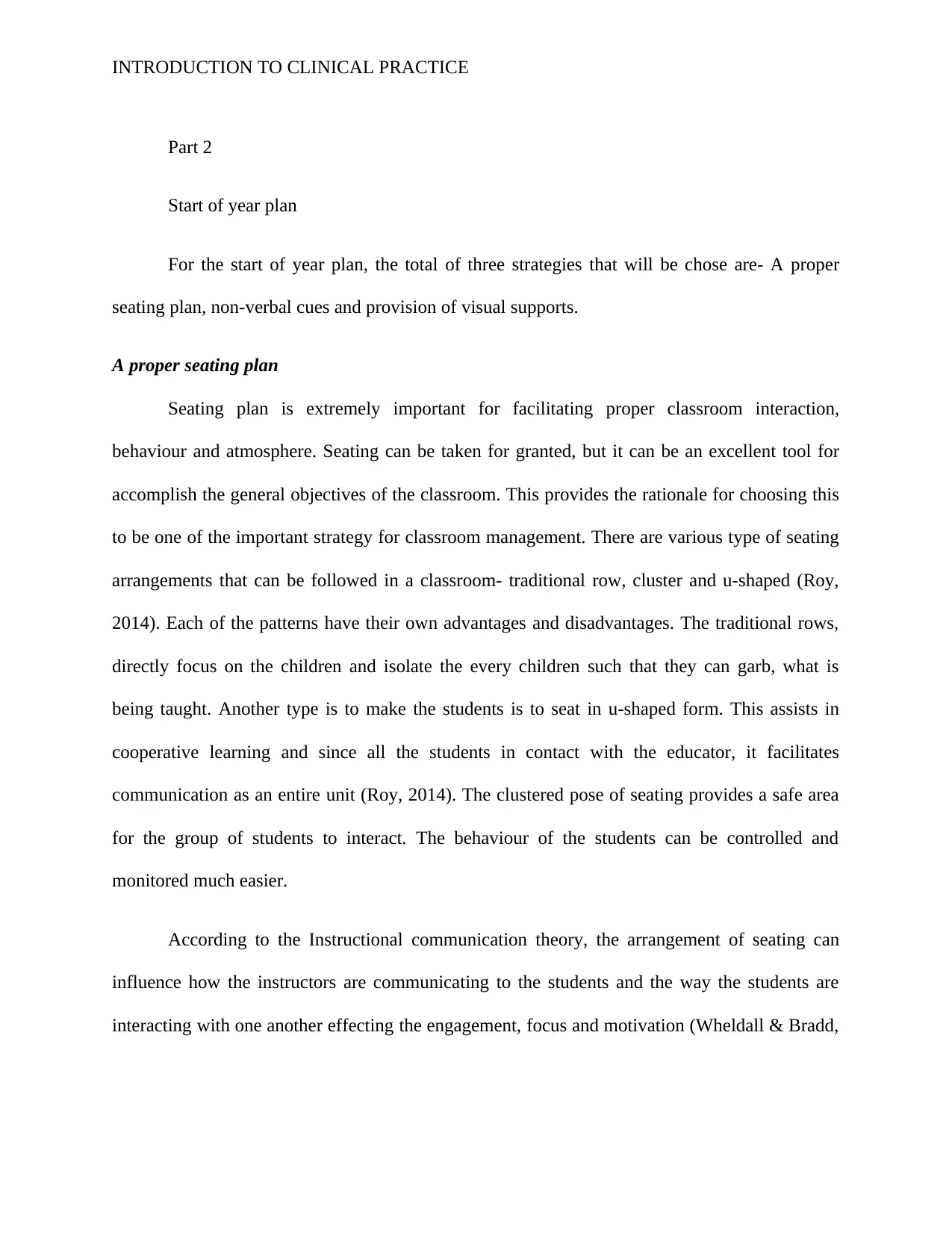
INTRODUCTION TO CLINICAL PRACTICE
Part 2
Start of year plan
For the start of year plan, the total of three strategies that will be chose are- A proper
seating plan, non-verbal cues and provision of visual supports.
A proper seating plan
Seating plan is extremely important for facilitating proper classroom interaction,
behaviour and atmosphere. Seating can be taken for granted, but it can be an excellent tool for
accomplish the general objectives of the classroom. This provides the rationale for choosing this
to be one of the important strategy for classroom management. There are various type of seating
arrangements that can be followed in a classroom- traditional row, cluster and u-shaped (Roy,
2014). Each of the patterns have their own advantages and disadvantages. The traditional rows,
directly focus on the children and isolate the every children such that they can garb, what is
being taught. Another type is to make the students is to seat in u-shaped form. This assists in
cooperative learning and since all the students in contact with the educator, it facilitates
communication as an entire unit (Roy, 2014). The clustered pose of seating provides a safe area
for the group of students to interact. The behaviour of the students can be controlled and
monitored much easier.
According to the Instructional communication theory, the arrangement of seating can
influence how the instructors are communicating to the students and the way the students are
interacting with one another effecting the engagement, focus and motivation (Wheldall & Bradd,
Part 2
Start of year plan
For the start of year plan, the total of three strategies that will be chose are- A proper
seating plan, non-verbal cues and provision of visual supports.
A proper seating plan
Seating plan is extremely important for facilitating proper classroom interaction,
behaviour and atmosphere. Seating can be taken for granted, but it can be an excellent tool for
accomplish the general objectives of the classroom. This provides the rationale for choosing this
to be one of the important strategy for classroom management. There are various type of seating
arrangements that can be followed in a classroom- traditional row, cluster and u-shaped (Roy,
2014). Each of the patterns have their own advantages and disadvantages. The traditional rows,
directly focus on the children and isolate the every children such that they can garb, what is
being taught. Another type is to make the students is to seat in u-shaped form. This assists in
cooperative learning and since all the students in contact with the educator, it facilitates
communication as an entire unit (Roy, 2014). The clustered pose of seating provides a safe area
for the group of students to interact. The behaviour of the students can be controlled and
monitored much easier.
According to the Instructional communication theory, the arrangement of seating can
influence how the instructors are communicating to the students and the way the students are
interacting with one another effecting the engagement, focus and motivation (Wheldall & Bradd,
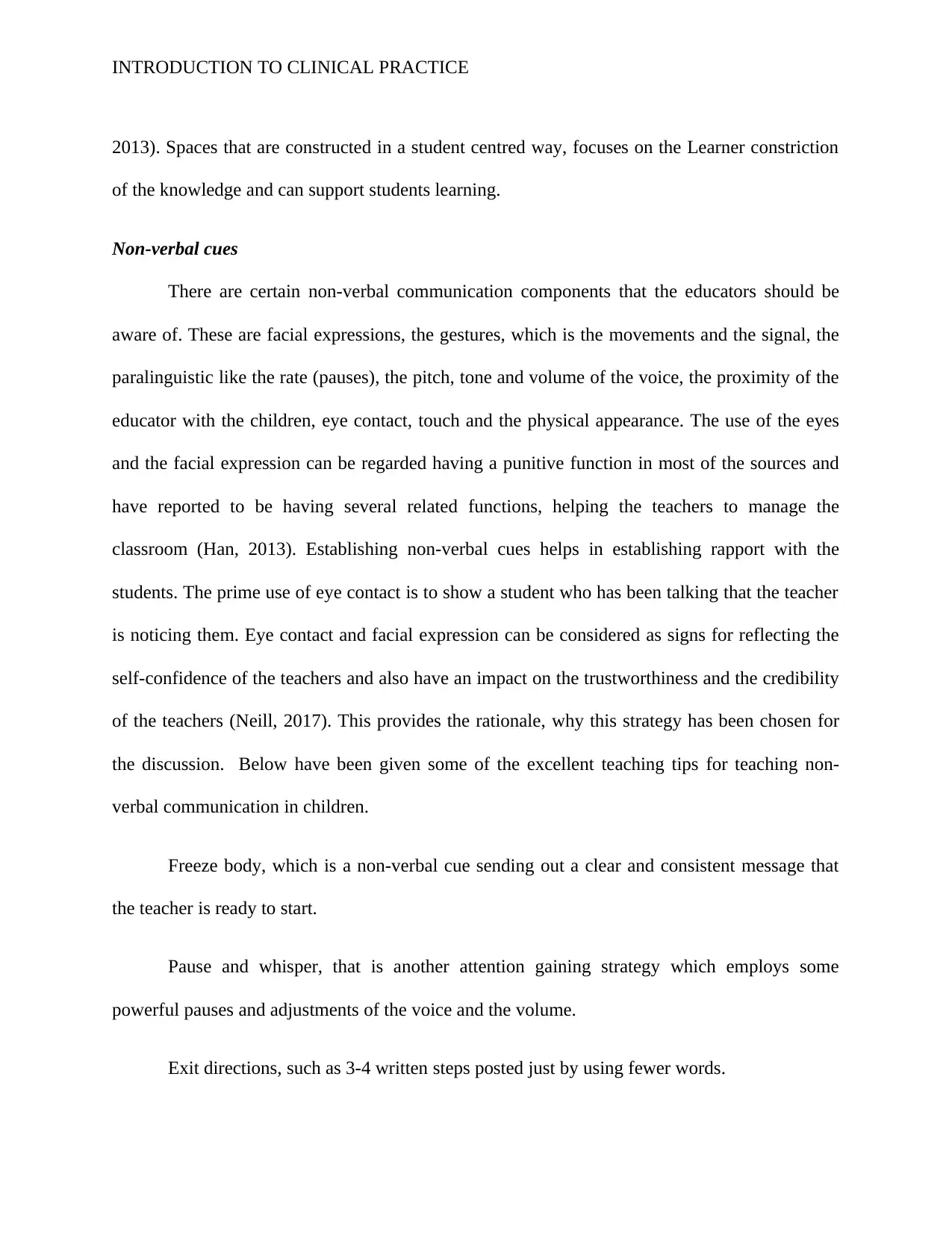
INTRODUCTION TO CLINICAL PRACTICE
2013). Spaces that are constructed in a student centred way, focuses on the Learner constriction
of the knowledge and can support students learning.
Non-verbal cues
There are certain non-verbal communication components that the educators should be
aware of. These are facial expressions, the gestures, which is the movements and the signal, the
paralinguistic like the rate (pauses), the pitch, tone and volume of the voice, the proximity of the
educator with the children, eye contact, touch and the physical appearance. The use of the eyes
and the facial expression can be regarded having a punitive function in most of the sources and
have reported to be having several related functions, helping the teachers to manage the
classroom (Han, 2013). Establishing non-verbal cues helps in establishing rapport with the
students. The prime use of eye contact is to show a student who has been talking that the teacher
is noticing them. Eye contact and facial expression can be considered as signs for reflecting the
self-confidence of the teachers and also have an impact on the trustworthiness and the credibility
of the teachers (Neill, 2017). This provides the rationale, why this strategy has been chosen for
the discussion. Below have been given some of the excellent teaching tips for teaching non-
verbal communication in children.
Freeze body, which is a non-verbal cue sending out a clear and consistent message that
the teacher is ready to start.
Pause and whisper, that is another attention gaining strategy which employs some
powerful pauses and adjustments of the voice and the volume.
Exit directions, such as 3-4 written steps posted just by using fewer words.
2013). Spaces that are constructed in a student centred way, focuses on the Learner constriction
of the knowledge and can support students learning.
Non-verbal cues
There are certain non-verbal communication components that the educators should be
aware of. These are facial expressions, the gestures, which is the movements and the signal, the
paralinguistic like the rate (pauses), the pitch, tone and volume of the voice, the proximity of the
educator with the children, eye contact, touch and the physical appearance. The use of the eyes
and the facial expression can be regarded having a punitive function in most of the sources and
have reported to be having several related functions, helping the teachers to manage the
classroom (Han, 2013). Establishing non-verbal cues helps in establishing rapport with the
students. The prime use of eye contact is to show a student who has been talking that the teacher
is noticing them. Eye contact and facial expression can be considered as signs for reflecting the
self-confidence of the teachers and also have an impact on the trustworthiness and the credibility
of the teachers (Neill, 2017). This provides the rationale, why this strategy has been chosen for
the discussion. Below have been given some of the excellent teaching tips for teaching non-
verbal communication in children.
Freeze body, which is a non-verbal cue sending out a clear and consistent message that
the teacher is ready to start.
Pause and whisper, that is another attention gaining strategy which employs some
powerful pauses and adjustments of the voice and the volume.
Exit directions, such as 3-4 written steps posted just by using fewer words.
⊘ This is a preview!⊘
Do you want full access?
Subscribe today to unlock all pages.

Trusted by 1+ million students worldwide
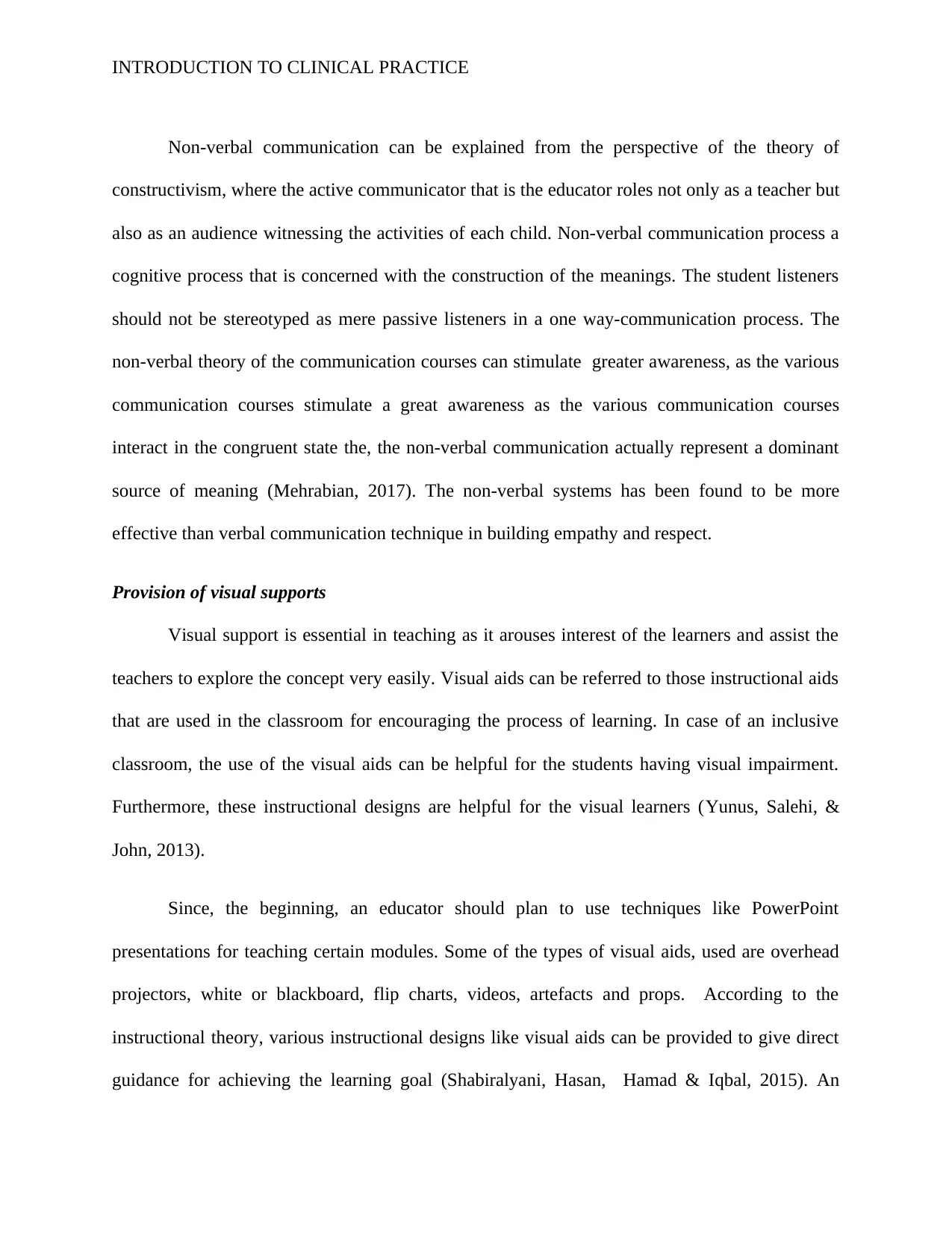
INTRODUCTION TO CLINICAL PRACTICE
Non-verbal communication can be explained from the perspective of the theory of
constructivism, where the active communicator that is the educator roles not only as a teacher but
also as an audience witnessing the activities of each child. Non-verbal communication process a
cognitive process that is concerned with the construction of the meanings. The student listeners
should not be stereotyped as mere passive listeners in a one way-communication process. The
non-verbal theory of the communication courses can stimulate greater awareness, as the various
communication courses stimulate a great awareness as the various communication courses
interact in the congruent state the, the non-verbal communication actually represent a dominant
source of meaning (Mehrabian, 2017). The non-verbal systems has been found to be more
effective than verbal communication technique in building empathy and respect.
Provision of visual supports
Visual support is essential in teaching as it arouses interest of the learners and assist the
teachers to explore the concept very easily. Visual aids can be referred to those instructional aids
that are used in the classroom for encouraging the process of learning. In case of an inclusive
classroom, the use of the visual aids can be helpful for the students having visual impairment.
Furthermore, these instructional designs are helpful for the visual learners (Yunus, Salehi, &
John, 2013).
Since, the beginning, an educator should plan to use techniques like PowerPoint
presentations for teaching certain modules. Some of the types of visual aids, used are overhead
projectors, white or blackboard, flip charts, videos, artefacts and props. According to the
instructional theory, various instructional designs like visual aids can be provided to give direct
guidance for achieving the learning goal (Shabiralyani, Hasan, Hamad & Iqbal, 2015). An
Non-verbal communication can be explained from the perspective of the theory of
constructivism, where the active communicator that is the educator roles not only as a teacher but
also as an audience witnessing the activities of each child. Non-verbal communication process a
cognitive process that is concerned with the construction of the meanings. The student listeners
should not be stereotyped as mere passive listeners in a one way-communication process. The
non-verbal theory of the communication courses can stimulate greater awareness, as the various
communication courses stimulate a great awareness as the various communication courses
interact in the congruent state the, the non-verbal communication actually represent a dominant
source of meaning (Mehrabian, 2017). The non-verbal systems has been found to be more
effective than verbal communication technique in building empathy and respect.
Provision of visual supports
Visual support is essential in teaching as it arouses interest of the learners and assist the
teachers to explore the concept very easily. Visual aids can be referred to those instructional aids
that are used in the classroom for encouraging the process of learning. In case of an inclusive
classroom, the use of the visual aids can be helpful for the students having visual impairment.
Furthermore, these instructional designs are helpful for the visual learners (Yunus, Salehi, &
John, 2013).
Since, the beginning, an educator should plan to use techniques like PowerPoint
presentations for teaching certain modules. Some of the types of visual aids, used are overhead
projectors, white or blackboard, flip charts, videos, artefacts and props. According to the
instructional theory, various instructional designs like visual aids can be provided to give direct
guidance for achieving the learning goal (Shabiralyani, Hasan, Hamad & Iqbal, 2015). An
Paraphrase This Document
Need a fresh take? Get an instant paraphrase of this document with our AI Paraphraser
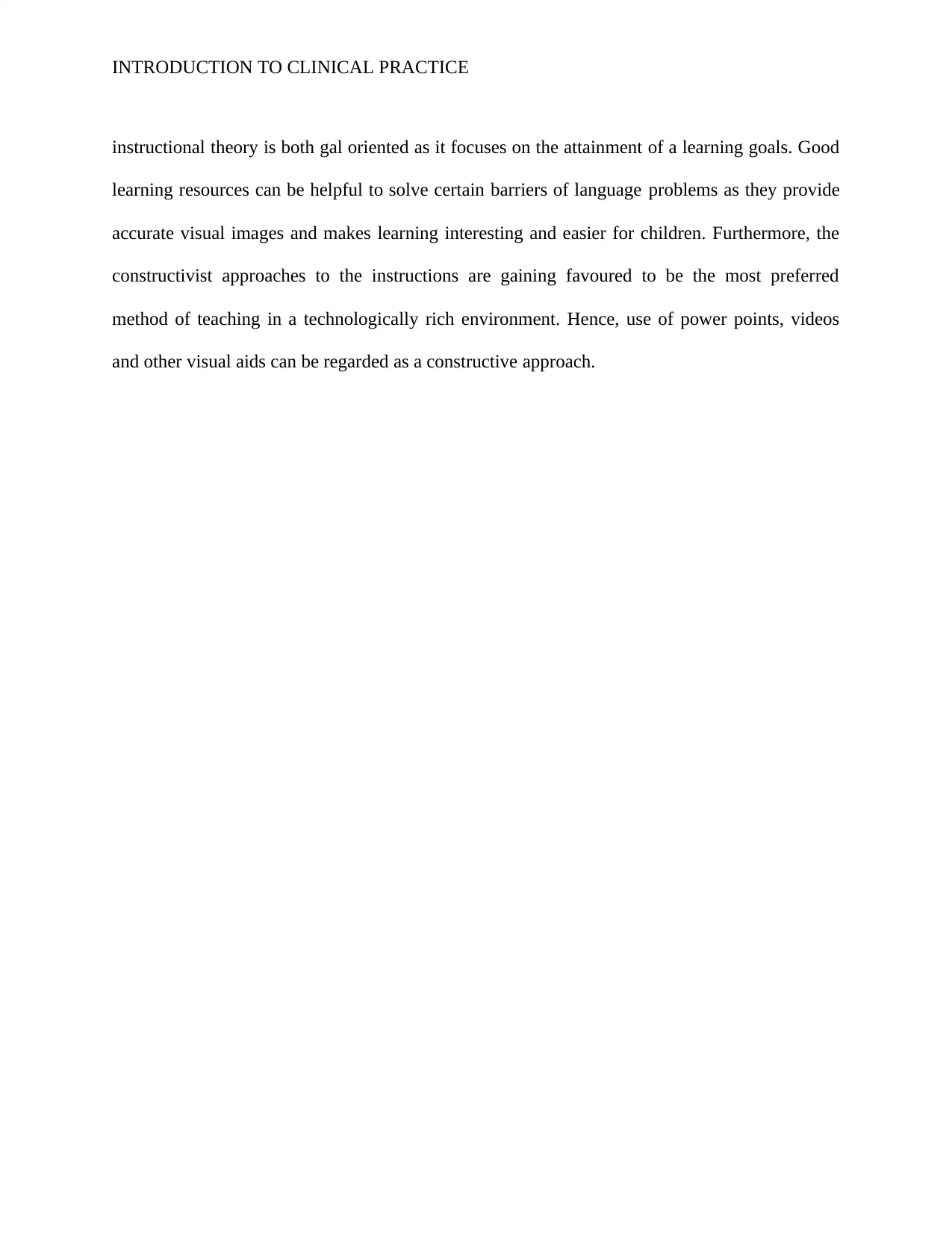
INTRODUCTION TO CLINICAL PRACTICE
instructional theory is both gal oriented as it focuses on the attainment of a learning goals. Good
learning resources can be helpful to solve certain barriers of language problems as they provide
accurate visual images and makes learning interesting and easier for children. Furthermore, the
constructivist approaches to the instructions are gaining favoured to be the most preferred
method of teaching in a technologically rich environment. Hence, use of power points, videos
and other visual aids can be regarded as a constructive approach.
instructional theory is both gal oriented as it focuses on the attainment of a learning goals. Good
learning resources can be helpful to solve certain barriers of language problems as they provide
accurate visual images and makes learning interesting and easier for children. Furthermore, the
constructivist approaches to the instructions are gaining favoured to be the most preferred
method of teaching in a technologically rich environment. Hence, use of power points, videos
and other visual aids can be regarded as a constructive approach.
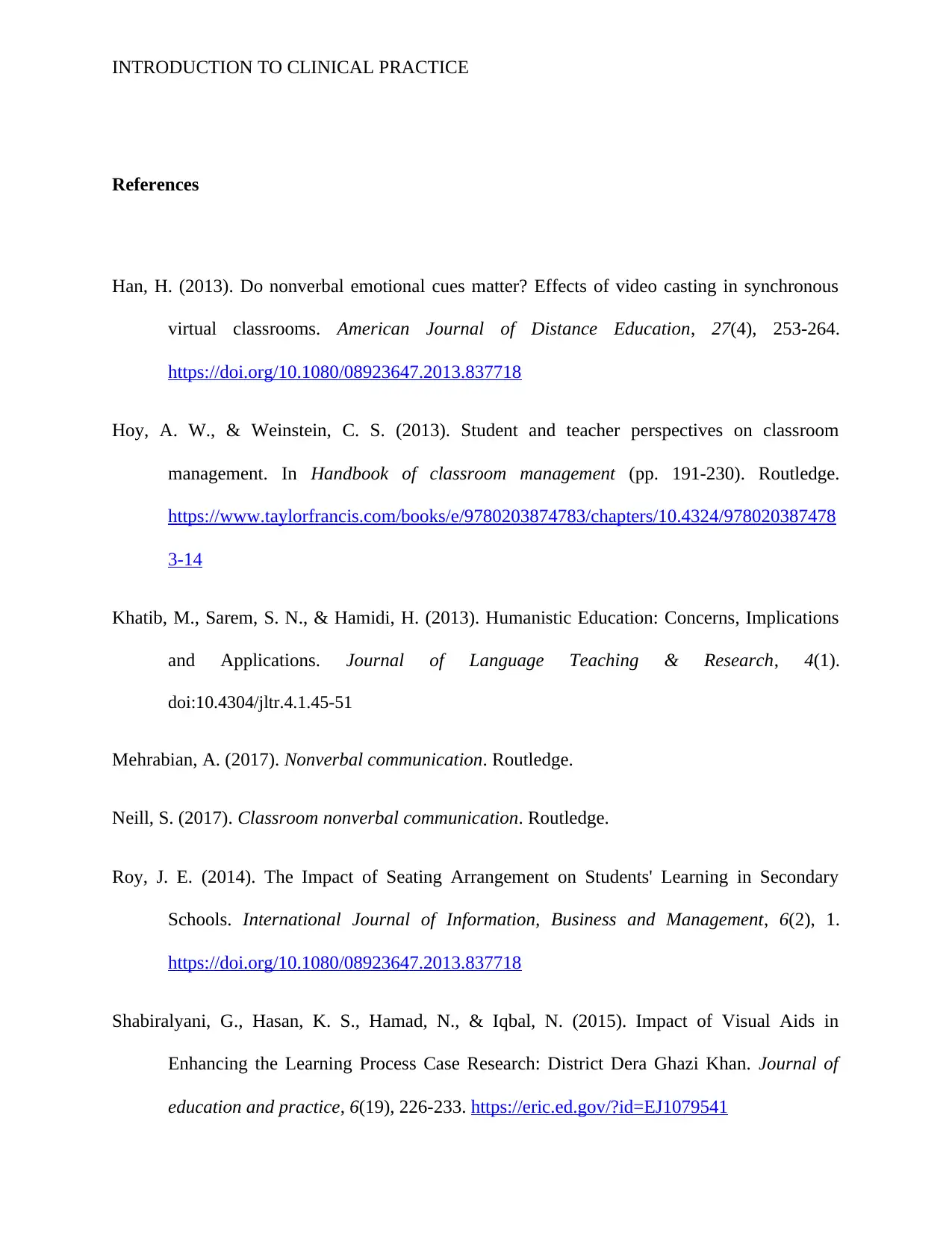
INTRODUCTION TO CLINICAL PRACTICE
References
Han, H. (2013). Do nonverbal emotional cues matter? Effects of video casting in synchronous
virtual classrooms. American Journal of Distance Education, 27(4), 253-264.
https://doi.org/10.1080/08923647.2013.837718
Hoy, A. W., & Weinstein, C. S. (2013). Student and teacher perspectives on classroom
management. In Handbook of classroom management (pp. 191-230). Routledge.
https://www.taylorfrancis.com/books/e/9780203874783/chapters/10.4324/978020387478
3-14
Khatib, M., Sarem, S. N., & Hamidi, H. (2013). Humanistic Education: Concerns, Implications
and Applications. Journal of Language Teaching & Research, 4(1).
doi:10.4304/jltr.4.1.45-51
Mehrabian, A. (2017). Nonverbal communication. Routledge.
Neill, S. (2017). Classroom nonverbal communication. Routledge.
Roy, J. E. (2014). The Impact of Seating Arrangement on Students' Learning in Secondary
Schools. International Journal of Information, Business and Management, 6(2), 1.
https://doi.org/10.1080/08923647.2013.837718
Shabiralyani, G., Hasan, K. S., Hamad, N., & Iqbal, N. (2015). Impact of Visual Aids in
Enhancing the Learning Process Case Research: District Dera Ghazi Khan. Journal of
education and practice, 6(19), 226-233. https://eric.ed.gov/?id=EJ1079541
References
Han, H. (2013). Do nonverbal emotional cues matter? Effects of video casting in synchronous
virtual classrooms. American Journal of Distance Education, 27(4), 253-264.
https://doi.org/10.1080/08923647.2013.837718
Hoy, A. W., & Weinstein, C. S. (2013). Student and teacher perspectives on classroom
management. In Handbook of classroom management (pp. 191-230). Routledge.
https://www.taylorfrancis.com/books/e/9780203874783/chapters/10.4324/978020387478
3-14
Khatib, M., Sarem, S. N., & Hamidi, H. (2013). Humanistic Education: Concerns, Implications
and Applications. Journal of Language Teaching & Research, 4(1).
doi:10.4304/jltr.4.1.45-51
Mehrabian, A. (2017). Nonverbal communication. Routledge.
Neill, S. (2017). Classroom nonverbal communication. Routledge.
Roy, J. E. (2014). The Impact of Seating Arrangement on Students' Learning in Secondary
Schools. International Journal of Information, Business and Management, 6(2), 1.
https://doi.org/10.1080/08923647.2013.837718
Shabiralyani, G., Hasan, K. S., Hamad, N., & Iqbal, N. (2015). Impact of Visual Aids in
Enhancing the Learning Process Case Research: District Dera Ghazi Khan. Journal of
education and practice, 6(19), 226-233. https://eric.ed.gov/?id=EJ1079541
⊘ This is a preview!⊘
Do you want full access?
Subscribe today to unlock all pages.

Trusted by 1+ million students worldwide
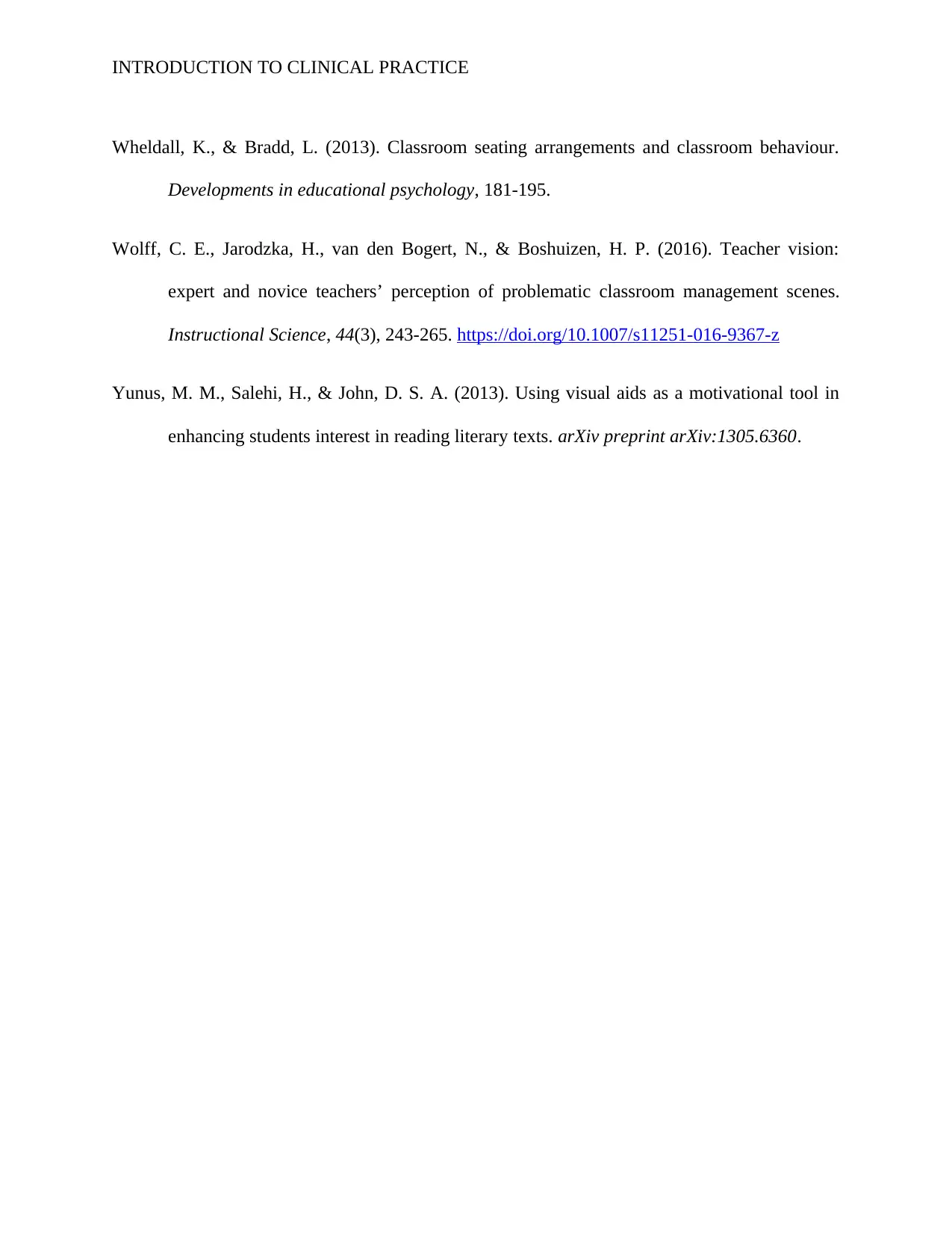
INTRODUCTION TO CLINICAL PRACTICE
Wheldall, K., & Bradd, L. (2013). Classroom seating arrangements and classroom behaviour.
Developments in educational psychology, 181-195.
Wolff, C. E., Jarodzka, H., van den Bogert, N., & Boshuizen, H. P. (2016). Teacher vision:
expert and novice teachers’ perception of problematic classroom management scenes.
Instructional Science, 44(3), 243-265. https://doi.org/10.1007/s11251-016-9367-z
Yunus, M. M., Salehi, H., & John, D. S. A. (2013). Using visual aids as a motivational tool in
enhancing students interest in reading literary texts. arXiv preprint arXiv:1305.6360.
Wheldall, K., & Bradd, L. (2013). Classroom seating arrangements and classroom behaviour.
Developments in educational psychology, 181-195.
Wolff, C. E., Jarodzka, H., van den Bogert, N., & Boshuizen, H. P. (2016). Teacher vision:
expert and novice teachers’ perception of problematic classroom management scenes.
Instructional Science, 44(3), 243-265. https://doi.org/10.1007/s11251-016-9367-z
Yunus, M. M., Salehi, H., & John, D. S. A. (2013). Using visual aids as a motivational tool in
enhancing students interest in reading literary texts. arXiv preprint arXiv:1305.6360.
1 out of 10
Related Documents
Your All-in-One AI-Powered Toolkit for Academic Success.
+13062052269
info@desklib.com
Available 24*7 on WhatsApp / Email
![[object Object]](/_next/static/media/star-bottom.7253800d.svg)
Unlock your academic potential
Copyright © 2020–2025 A2Z Services. All Rights Reserved. Developed and managed by ZUCOL.





